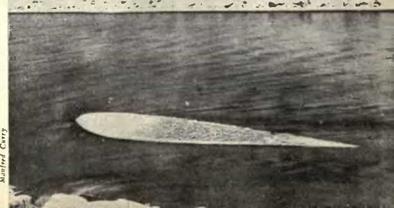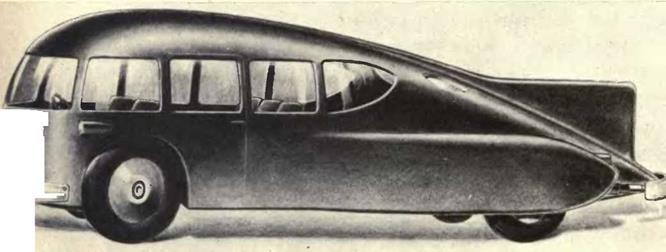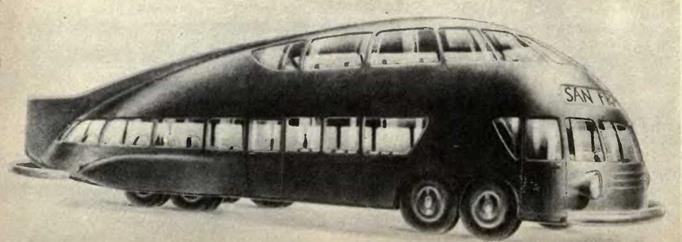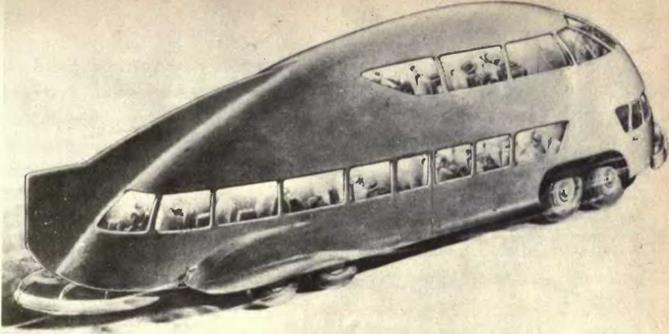riving to-day’s motor car is a peculiar experience for one who understands in the least degree the principles of aerodynamics; for he realizes that the mechanism under his control is so inadequately designed from this viewpoint that it would be more efficient if it were operated with the rear end to the front.””
Put your hand out of the window of a car traveling at thirty miles an hour, and gauge the force of the wind resistance. Do the same at sixty miles an hour. Compare, for the sake of a rough guess, the area of your hand with the total area of the car opposed to the same pressure. In this, you have the basis for a rough calculation of the tremendous inefficiency, in one respect, of to-day’s motor car. Only realize, in addition, that the partial vacuum caused by projections such as lamps and fenders, abrupt steps or changes in contour such as the windshield, and the vacuum at the rear of the body itself more than doubles the resistance caused by the wind pressure at the front.
The subject of aerodynamics is anything but simple. Some applications of its principles, however, are not difficult to define. An object is airfoiled when
its exterior surface is so designed that upon being projected through air, a useful dynamic reaction is imparted to the object by the action of the air. The lift of an airplane wing is an excellent example of a useful dynamic reaction. An object is streamlined when its exterior surface is so designed that upon passing through a fluid such as water or air the object creates the least disturbance in the fluid in the form of eddies or partial vacua tending to produce resistance. In other words, an object is airfoiled in order to create a
|
disturbance and an object is streamlined in order to eliminate disturbances in the media through which they pass.
It is well known that a drop of water falling in still air assumes an almost perfect streamline form. This form is approximately that of an egg, though the small end of the drop tapers more sharply to a conical point. In falling, the larger and blunt end of the drop is foremost. This is the shape that creates the least turbulence in the form of eddies and partial vacua which increase wind resistance.” A stationary sand bar 34 ‘ SHEET OF |CE, N flowing stream demonstrating

NATURE’S STREAMLINING
|
|
__ the wire but tapered out to a lengtl

![]()
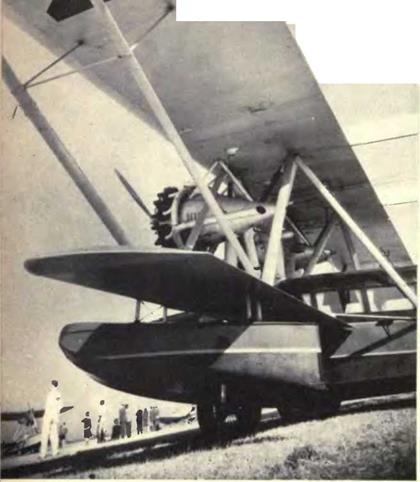 і of about three diameters, merely be f cause it eliminates the rear vacuum.5
і of about three diameters, merely be f cause it eliminates the rear vacuum.5
з
ce
Theoretically, then, streamlining requires that the broadest part of tb motor car be at the front and that al surfaces and projections which creat eddies or cause retarding suctioi should be eliminated. Various experi ments have proved the validity о this theory. It is an established fac that the motor car of to-day going a forty miles per hour uses sixty pe cent of the engine’s power in over coming wind resistance.
Automotive engineers understan< the fundamentals necessary for solv ing the problem of wind resistance But motor-car manufacturers hav never encouraged their engineers t< tackle the problem, not at least in the thorough-going manner that airplan< manufacturers have been forced to. The hesitancy of the motor-car manu facturer is based upon the theory that the public likes the appearance o: present-day cars and would not like one completely streamlined. They an willing to make the necessary change after some one else has taken the lead In the automobile industry the situation with regard to streamlining is similar to that which formerly existed with regard to lowering the center ol gravity. For years there was talk about the necessity of lowering the motoi
car’s center of gravity, but manufacturers waited for the other fellow to do it first. Mr. Cord did it. Immediately, the others followed.
When automobile manufacturers first found themselves in need of bodies for chassis, they naturally appealed to the designers of horse-drawn carriages.54 What the carriage designers offered had most of the main characteristics of the vehicle on which they had previously concentrated their attention. Gradually new features such as the windshield were added, and the whole structure became heavier.57 When the public showed a preference for the closed car, the design of motor-car bodies greatly improved. But it was not until after the War that designers and manufacturers made a determined effort to abandon carriage ideas.
The narrow point of view that some of the various companies take is the influential factor in the design of to-day’s motor car. Basic changes are expensive and to justify themselves must be unusually successful. Possibly executives find it difficult to maintain a perspective, owing to the fact that they are surrounded by subordinates who reflect rather than stimulate the executive’s viewpoint. The executive may think that by minor changes here and there, after the manner of fashion designers with women’s clothes, by changing the shape of moldings or of hardware, and by adding new gadgets, he is improving the design of the car. When visual design gives major emphasis to details, the result can only be mediocre.
Having successfully overcome the enormous difficulties involved in making the motor car work, the industry is now endeavoring to make it beautiful. This beauty is of a questionable sort. Stylistic in trend, it attacks the problem superficially, modishly. Between most of these stylistic alterations and their utility there is no direct relation.
A tendency towards simplification has been the dominant factor in the improved appearance of motor-car bodies in the past few years. A few motor
cars on the market, although they do not represent my own beliefs, are nevertheless good-looking according to their own standards, and they are well designed up to that point. They are cars that do not make the seasonal changes which makers of cheap popular cars believe necessary.3* A few makers of high-grade motor cars have over a period of years built a reputation by emphasizing two ideas — that their cars would be a long time in wearing out, and that they would not soon look out of date. If, in part, they have ceased to carry conviction, it is primarily because the design of the body is not sufficiently organic. Their style is applied — too much on the surface, too much a continuation of precedent, not sufficiently and inherently directed toward that of the ultimate motor car.3*
For years I have observed trends in design at the National Automobile Show. One notices slight improvements, such as the slanting windshield and the radiator with rounded front. By a process of timid nibbling, manufacturers are slowly approaching the application of аёп^упагтс principles. Meanwhile, each succeeding show offers
36 • MOTOR CAR DESIGNED BY DR. DITTLINGER 1898
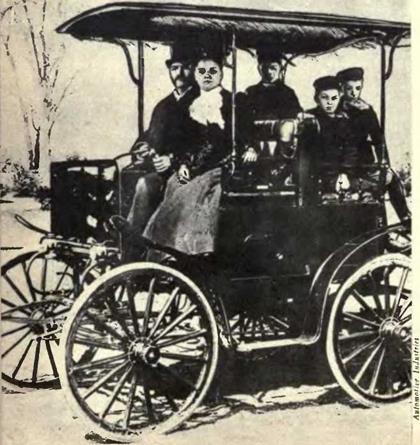 evidence, in the multiplication of gadgets and so-called selling points, that the end of an era has arrived. Scores of thousands of the interested public throng the show to greet the new. What they behold is something quite the opposite. For, the National Automobile Show, instead of offering truly progressive design, presents to the public the opportunity to inspect an assemblage of variants of a single type that is already obsolescent.
evidence, in the multiplication of gadgets and so-called selling points, that the end of an era has arrived. Scores of thousands of the interested public throng the show to greet the new. What they behold is something quite the opposite. For, the National Automobile Show, instead of offering truly progressive design, presents to the public the opportunity to inspect an assemblage of variants of a single type that is already obsolescent.
It is a surprising fact that the average automobile manufacturer believes that the general public not only enjoys but approves the show. If the manufacturer would listen to disinterested remarks, if he would detach himself from the influence of approving employees, he would discover that each year the public is hopeful but disappointed because, having read announcements of innovations and improvements, they do not find them except in minor instances. To-day’s most advanced type of motor cars, with the exception of a few specially built racing models, are at least ten years behind the actual knowledge of the industry. On numerous occasions, I have discussed this topic with leading manufacturers and engineers in the industry; and I find that, when they divorce themselves sufficiently from current sales problems and speak frankly, they concur in at least a broad sense with what I am saying here.
One of the chief factors restraining the manufacturer from making more fundamental annual changes in his cars is the cost of tooling up and the cost of dies. To make a complete set of dies for a motor car requires a considerable expenditure of money. The present method is to alter annually as few dies as possible, sufficient however to make changes which will be noticed by the public, and which may be advertised as the new model. I do not imply that in the motor car of to-day,
1 37 • MOTOR CAR DESIGNED BY VEL1E 1908
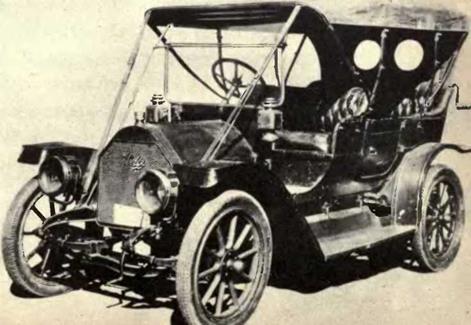 badly designed as it is | from the viewpoint of
badly designed as it is | from the viewpoint of
I
function, there is not a i certain stirring kind of appeal. In so far as it exists, it is the result of an attempt to make the motor car look its part.
But it can never exert the same force of appeal that the projectile-like racing car does until it is designed in accord with the same functional principles.
We admire the swordfish, seagull, greyhound, Arab stallion and Durham bull because they seem made to do their particular work. When the motor car, bus, truck and tractor have evolved into the essential forms determined by what these machines have to do, they will not need surface ornamentation to make them beautiful. Their beauty will be inherent and that will be all the beauty that they need. This is not meant to indicate that if the engineer
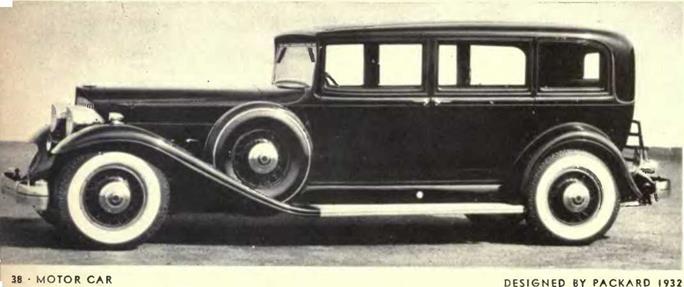
does his job well the result will be beautiful. Here is where the artist is essential, for he knows how to make a thing of beauty with the minimum of means. From this point on, he should be left alone. Prior to this point the two should work in close collaboration with each other. The artist should have complete freedom, assuming of course that he violates no engineering requirement. The final result must have the sincere approval of both — or something is wrong with it.
For the constantly recurrent offerings of ornate vehicles with minor
improvements instead of motor cars expressive of their function, the public is held responsible on the ground that the public is slow to adjust itself to new impressions. I am convinced that the public is ahead of the manufacturer and eagerly awaiting that car which will look its part.
As one reason for this conviction, I cite the experience of a certain courageous manufacturer who not long since came out with his solution to the problem, a car with a front-wheel drive. The interest on the part of the public was unprecedented and this despite the car being in an expensive price class. Sales have not lived up to expectations, but this is due to other problems than the principle involved, or the response of the public. As is well known, one of the great advantages in owning a Ford is that you can find a Ford service station almost anywhere. The same condition exists to a certain extent with many other cars. But when the front-wheel-drive car came, with its radical departure from precedent, the public feared that in case of engine or other trouble they would have less chance of getting repairs made easily. Nevertheless, in spirit, the motoring public applauded Mr. Cord, and if his principle proves to be right the public will continue with him.
In conversation with automotive engineers and in the technical journals where they discuss shop, I frequently discover convincing evidence that they are restless over the present reactionary trend of motor-car design. I venture to say that among my criticisms there is not one that has not repeatedly been voiced by automotive designers who, by circumstances beyond their control, are compelled to continue producing designs that are far inferior to what they could accomplish if circumstances permitted the application of existing knowledge.
In the critical engineer’s indictment of the present-day car, hardly any aspect escapes attention. The ratio of empty weight to useful load is extravagantly high. The power plant occupies the forward part of the chassis, the
[Я]
very position that should afford clear vision to the driver and the best sightseeing advantages. By this position of the motor, the small car is deprived of roomy comfort. Furthermore, this position of the motor contributes directly to discomfort through vibration, odor, and excess heat in summer. Without success, I have tried to find one good reason why the power plant should monopolize space at the front. I am convinced that it is entirely the result of the horse-drawn vehicle precedent.
Distributed throughout the present-day car, as though by chance, are the most vital parts of the mechanism — engine, clutch, transmission, and differential. Presently it will be the obligation of designers to collect this miscellany and to arrange it organically into one unit. Possibly, even the rear wheels will be included in this unit.
We may anticipate a further great improvement — that the properly organized power unit will eventually be detachable without great difficulty. It will then be possible to leave your motor for repairs or overhauling, insert another unit, and have the use of your own car while the repair work is being done. In to-day’s car there are too many points requiring attention and they are too widely separated. To illustrate: though most manufacturers recommend that the battery should be tested at least once a week, the battery is

 placed somewhere about the car in a position so difficult of access that one might infer the manufacturer’s intention is to hide it. With the exception, possibly, of the engine, nearly all parts lack accessibility. Wheel suspension can justly be
placed somewhere about the car in a position so difficult of access that one might infer the manufacturer’s intention is to hide it. With the exception, possibly, of the engine, nearly all parts lack accessibility. Wheel suspension can justly be
criticised. There is an excess of unsprung weight. Throughout the car as a whole, the distribution of weight is poor.
A wasteful characteristic of to-day’s motor car is the space allowed for the overhang of mud guards. The width of to-morrow’s car will undoubtedly be that of present-day mud guards with wheels inset in the body. Mud guards are destined to disappear entirely. Springs of an entirely new design are necessary. When these are developed, each wheel will be independently swung. New type springs and power plants will make possible the use of a lighter frame, which will be incorporated into the body structure. Most cars are now so low, as regards head room, that getting in and out is a matter of difficulty. A needed improvement is a type of forced draft ventilation, obviating the necessity of opening windows for air, to the extreme discomfort of the passenger. At a stroke, the designer can eliminate all moldings and reduce the number and cost of dies used in the making of the body parts.

A few years ago Glenn Curtiss, one of our foremost aviation designers, carried on a series of experiments with motor cars to ascertain the extent to which streamlining alone would increase their speed. He took a stock coupe, which as delivered from the factory ran at a maximum speed of seventy-four miles per hour,3,A and removed the body superstructure. He replaced it on the chassis backwards and driving it with the same motor, he was able to increase the speed of the car to over eighty-seven miles an hour.”* He then built a trailer which weighed fifteen hundred pounds and fastened it to the rear of the car. The trailer was built in a streamline form to eliminate the vacuum at the rear of the coupe. Despite doubling the weight that the engine had to pull, the streamlining increased the speed of the car eleven per cent.”c Further tests by Curtiss proved that the speed of the average automobile could be increased twenty per cent when going only twenty-five miles an hour merely by streamlining. This ratio increases considerably as the speed increases.
Employing the principles of aerodynamics, I designed a motor car four years ago, and called it Car Number 5, meaning a car of five years from then. Working backward in four stages, we succeeded, by the time we came to Car Number 1, in designing an automobile which, except for its extreme simplicity, would resemble present-day cars.40 It could be driven on the streets – now without attracting attention other than casual admiration. Each of the five models represent a twenty per cent change over the previous one as each is advanced by degrees toward a definite ideal standard — not in
|
R CAR NUMBER 8 DESIGNED BY NORMAN BEL GEDDES 1931 |
terms of transient modes. As the only ideas contained in these five models that have so far appeared (to my knowledge) in other cars, are in this Number 1 model, I am not illustrating the other four here.
That series of designs was developed for an average-priced car on an average wheel base. Automotive engineers have estimated that Car Number 1, as a result of the streamlining of the body, would make a speed of fifty – eight miles an hour with the same power as would be necessary to drive the existing rectangular car forty-five miles an hour. Other features of this car
which up to that time were innovations are: the round front radiator, the top folding down into the body; the windshield sliding vertically into body, driving lights turning with front wheels, the fuel tank and trunk compartment built into the body; the license plate built into the basic design, and the elimination of all moldings.40
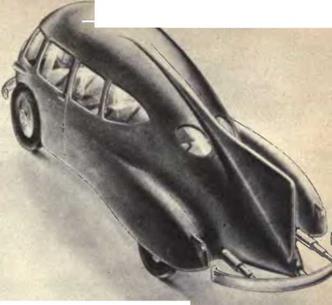 This car was designed for the then ■1
This car was designed for the then ■1
Graham-Paige Company (now the Gra – « • motor car number s
DESIGNED BY NORMAN BEL GEDDES 193
ham Motor Car Company). Mr. Ray Graham was more instrumental than any other one person in encouraging me to enter the industrial field. The car was never built, owing to psychological factors in the human make-up that have to do with timidity. The design impressed his various department heads as a little extreme. Nevertheless, had the stock market crashed a week later in the fall of 1929 a first test body of Car Number 1 would have been built at a maximum cost of eight thousand dollars and tried out on the roads. For that expenditure there might have been on the market two years ago the first step towards a new idea in automotive design. With the crash, the pioneering spirit which prompted this particular undertaking departed.
I have since designed another series of cars, incorporating ideas other than streamlining and which has resulted in a radical departure from our present conception of a motor car.41 The exterior shell of this series of cars is streamlined, other than on the ground side, to as near the drop form as is practicable. It is not designed for higher speed but for present-day speed with less power. Campbell’s Bluebird was designed for the highest possible speed. The major problem in designing that car was to keep it from rising off the ground.
[«]
In the case of the present car, one of the main problems has been to reduce the power. Hence, the difference in design.
My design seeks to eliminate all projections as well as flat surfaces normal to the wind which tend to create resistance. In addition, increased convenience and seating capacity have been provided.
 |
 |
One of these motor cars is designed on a 116-inch wheel base which places it in the middle group as to size and price, comparable to the Oldsmobile,
De Soto, and the medium-size Buicks and Chryslers. However, instead of five, it carries eight passengers very comfortably.
Although the car is completely streamlined, and to a much further extent than any other non-racing motor car to date, certain modifications have been made in the drop-form theory. In general, this car represents a simplification of most of the experiments in the past and more nearly approaches a perfect streamline form, although ultimate efficiency in this respect is impossible. The body tapers off at the rear, allowing the air to slip past with the least disturbance. This one feature in contrast to the present-day conventional form eliminates the enormous air pocket which is created at the rear of today’s enclosed car.” In the sedan of ordinary design, the air is actually eddying and whirling and holding back the progress of the car in varying amounts up to sixty per cent.
At first sight, you may not think this design looks pleasing or much like a motor car. You may think it odd. This results from the extent to which it is streamlined and to your being accustomed to the present type of motor car. Your grandparents would have felt the same way about the car you are driving. To myself and my staff the novelty of this Car Number 8 has worn off, and it appears more logical and attractive than present-day designs.

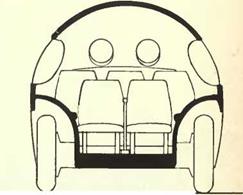 Numerous changes, some of them in the nature of innovations, have been made in keeping with the main objects of the design.43 The bulk of the car is forward.
Numerous changes, some of them in the nature of innovations, have been made in keeping with the main objects of the design.43 The bulk of the car is forward.
Headlights are inset in the front’ and shine through a glass that is flush with the surface. The two lamps are operated as a single unit. They are connected with the steering gear and turn as the car turns, so that in rounding a curve or corner at night the light is not off to one side. There are two small lights at each extreme side that
mark the dimensions of the car and serve as parking lights. Mud guards have been eliminated. Wheels are enclosed in the body. Otherwise, in connection with the wheels, there are no innovations. The car is controlled from the extreme front. The steering wheel is located directly over the forward axle. The steering mechanism is greatly simplified and more easily serviced and repaired.



 The engine is at the extreme rear and acts directly on the rear axle. This position makes it possible to centralize the power plant. With the elimination of the long transmission shaft, which is necessary when the engine is at the front, it becomes possible to lower the center of gravity, decreasing the danger of overturn when making curves at high speed. Placing the engine at the rear permits of better insulation against heat, noise and fumes, and simplifies repairing and service operations. A water-cooled motor is specified. Air for radiator cooling is provided for by louvers which force the air where desired. They are at the sides over the wheels and at the rear in the stabilizing fin.
The engine is at the extreme rear and acts directly on the rear axle. This position makes it possible to centralize the power plant. With the elimination of the long transmission shaft, which is necessary when the engine is at the front, it becomes possible to lower the center of gravity, decreasing the danger of overturn when making curves at high speed. Placing the engine at the rear permits of better insulation against heat, noise and fumes, and simplifies repairing and service operations. A water-cooled motor is specified. Air for radiator cooling is provided for by louvers which force the air where desired. They are at the sides over the wheels and at the rear in the stabilizing fin.
The interior design is purely functional. Increased seating space is the primary advantage.44 Eight passengers may be seated as follows: Two in individual front seats (driver and passenger) ; three in center chairs; three in the rear lounge. Complete visibility is provided for the driver and all passengers.4’ Neither engine hood, fenders or head lamps can obstruct it. The windows
extend without interruption entirely around the car. The window area is at least twenty per cent greater than that of conventional cars in the same class. Ventilation without draft is provided through louvers at the front. Air, coming through these louvers is conveyed between the outer shell and the insulation which forms the interior finish of the car. The air is distributed through grills.
The idea of bus transportation was introduced in 1905. The buses were merely elongated touring cars/6 Although the buses of to-day look big, roomy and comfortable, all that I have ridden in are distinctly uncomfortable. The Pickwick Duplex Coach is said to represent the most advanced bus design at the present time/7 It does not permit a passenger to relax any more than to-day’s airplane cabin does. Instead, you are continually bracing yourself against road shocks and jolts. These are among the disadvantages that I have endeavored to eliminate in my designs for buses.
 |
The same reasons for streamlining apply to the bus as to the motor car/1 It will result in greater speed at less engine power and in smoother riding qualities. The stabilizing fin, which is essential to prevent the rear from swinging when going at high rates of speed, contains the gasoline tank/’ Its gasoline capacity is sufficient to enable the bus to go from New York to Detroit (at four miles per gallon) without refueling. The weight of the fuel, even though it is variable, is, along with the weight of the engine, an important traction and stabilizing factor. The engine is over the rear axle, and at one side to facilitate servicing and to give passengers ready access to the observation lounge.”
Instead of the customary two wheels for steering in front there are four.4* This decreases the load per tire and increases the safety factor. If one of the forward tires blows out, the car, instead of swerving suddenly, continues to ride on three forward wheels, until it is convenient to replace the damaged wheel. Two spare wheels are carried in a compartment on the ceiling of the lower deck over the engine. The body design eliminates the necessity for a chassis.
The large baggage compartment on the rear upper deck is reached by ladders and may be opened from either side of the bus. It contains sufficient space to store baggage systematically.” There are two doors on the right side, one forward by the driver and another in the center.4* The driver can open or close both doors automatically without leaving his seat. I believe this is the only double-deck bus for interstate travel in which the space directly under the upper deck is utilized for seating passengers. The deck arrangement is similar to that of the heavy transit buses used only in urban transportation, such as the Fifth Avenue buses in New York. But buses of the type used on Fifth Avenue are too high, top-heavy, and unstable for high-speed transit.
Although the seating arrangement of the two decks is, in many ways, similar to the typical city bus, the over-all height has been lowered two feet.” As the center of gravity is lower, it is not top-heavy. The form has a great deal to do with permitting this improvement. The reduced floor level of the lower deck, made possible to a great extent by the elimination of the drive shaft
|
48 • MOTOR COACH NUMBER 2 DESIGNED BY NORMAN BEL GEDDES 1932
|
|
|
49 • MOTOR COACH NUMBER 2 DESIGNED BY NORMAN BEL GEDDES 1932
and other mechanisms under the floor (since the engine is located over the rear axle), lowers the center of gravity. A comfort advantage resulting from this lower center of gravity, is greater road stability. The wheel base of the bus is two hundred and fifty inches. It accommodates fifty-three persons, including driver and steward. The lower deck seats thirty-three persons;” the upper deck twenty.50 This seating capacity exceeds by twenty the average seating capacity of conventional buses with the same wheel base and is greater than that in any bus of equal cubic content yet designed. Twenty per cent more space is allowed per passenger than in any bus to-day. This increase in capacity has been obtained by an increase in width and body length. Even with these increases the bus still conforms to the present road statutes.55 With only two exceptions, there are no seats directly over the wheels.
The stairway to the second deck is over the right front wheels. Under these stairs is an especially designed lavatory and toilet." Opposite this stairway is a buffet equipped with generous refrigerator, electric range and other facilities for serving light hot or cold meals, drinks and ice-cream soda. A table can
 |
be installed in front of any chair as in a present-day Pullman car. A newsstand display is provided for on top of the engine compartment.’1 In the rear is an observation lounge, with seats facing the rear. No seat on either deck has any obstruction to prevent the passenger from looking out in all directions. Window mullions are so spaced that all of them come between seats rather than in the line of vision. The interior decorations are quiet and restful. All lighting is indirect. A radio is included. Air-conditioning equipment is specified which would eliminate tobacco smoke immediately.
In manufacture, on a mass production basis, the designs for these motor cars and buses offer considerable opportunities for economies owing to simplified fabrication, less exterior surface and centralized mechanical design.
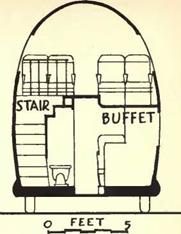 In the early days of the automobile, manufacturers concerned themselves only with making the machine go. Of late years, having succeeded with the first objective, the manufacturer has given his attention to such matters as comfort and 53 • motor coach number г-.
In the early days of the automobile, manufacturers concerned themselves only with making the machine go. Of late years, having succeeded with the first objective, the manufacturer has given his attention to such matters as comfort and 53 • motor coach number г-.
SECTION
appearance. It is my prediction that within the next two or norman bel geddes 1932 three years some farseeing manufacturer will again turn his attention to making his machine go, that this time his design will be the result of what has been learned in this motorized-buggy era. This means that he will start afresh and that his objective will be the ultimate form of the future motor car. This car will look very different from those you see on the road to-day but not very different from Car Number 8 as illustrated here. It will take the public about two years to accept the idea but they will do it for the simple reason that the basis for it is right. Then all the other manufacturers will follow this pioneer, but they will never reap the reward he will. It is the names of Columbus, Boone, Hamilton, Wright, Wanamaker, Ford, Lindbergh that mean something to us — not those of their trailers. It is the same with merchandising. The consuming mass has imagination and admiration. They like the new idea that is better than the old one and they idolize the fellow who blazed the way for it.


